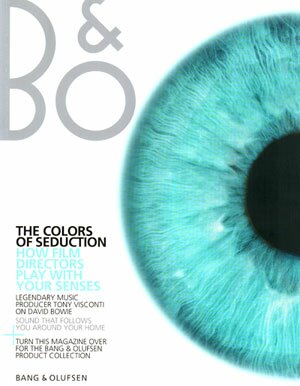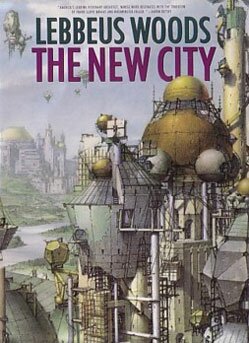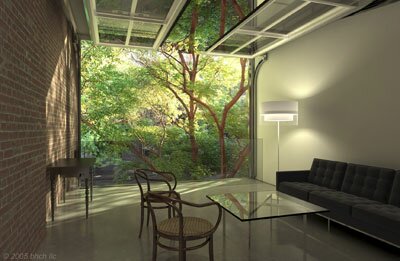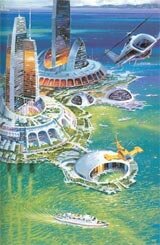OZ | October 27th, 2007 | Books and Games |  | Bookmark
| Bookmark

The holiday season almost upon us, video game publishers are about to deluge the market with AAA offerings throughout November. Several highly anticipated titles will be released with accompanying artbooks, highlighting the concept design and visual development that went into realizing these virtual worlds.
Continue reading ‘Game Art Books’
OZ | October 25th, 2007 | Advertising |  | Bookmark
| Bookmark

It’s no secret that for some time the ATP Tennis tour has struggled to attain the same level of popularity enjoyed by other sports. Excluding the four annual Grand Slam tournaments, which do not fall under the ATP Tour’s jurisdiction, tennis does not have a particularly high profile despite 63 ATP Tournaments in 30 countries. In an effort to build their image, the ATP has launched a new marketing campaign “Feel It”, executed by Ad Agency TAXI.
Continue reading ‘ATP Tennis - Feel It’
OZ | October 19th, 2007 | Advertising and Photography |  | Bookmark
| Bookmark

The work of Chennai based photographer Sharad Haksar has already been popularized in numerous blogs. His ingenious cultural commentary and effortless transition between fine art and commercial photography deserves another mention.
Continue reading ‘Sharad Haksar’
OZ | October 17th, 2007 | Print |  | Bookmark
| Bookmark

Intriguing experimentations in the physical form of the traditional magazine have appeared recently. Notably, a conceptual magazine design from topnotch graphic designer Philipp Zurmöhle dubbed Generate Magazine and award winning Australian design magazine POL Oxygen’s recent special Stretch issue conceived by Frost Design.
Continue reading ‘Reshaping the Magazine Format’
OZ | October 15th, 2007 | Print and Products |  | Bookmark
| Bookmark

Bang & Olufsen, perhaps the most prominent designer brand of cutting-edge audio products, has just released their 2007/2008 Collection catalog. While the brilliant ground-breaking BeoCenter 9000 along with its variants are long gone, there’s plenty to admire from the BeoCom 4 to EarSet2. Most noteworthy about the catalog, one half is the new 57 page B&O Magazine.
B&O Magazine features a variety of art and music articles that to some extent incorporate Bang & Olufsen products.
Continue reading ‘B&O Magazine’

Perhaps the greatest threat to noted historic buildings are the politics and economics of the moment. Here in New York City this is best exemplified by the destruction of the original Pennsylvania Station. This wondrous, grandiose structure designed by McKim, Mead and White, was built in 1910, only to be torn down a half century later to make way for Madison Square Garden. I’m a Knicks fan and it may be the world’s most famous arena, but it’s far from the world’s finest arena. To add insult to injury this prime piece of New York real estate is property tax free while owner James Dolan and company have mastered the fine art of throwing money away.
A New York Times editorial from October 30, 1963 noted, “Any city gets what it admires, will pay for, and, ultimately, deserves. Even when we had Penn Station, we couldn’t afford to keep it clean. We want and deserve tin-can architecture in a tinhorn culture. And we will probably be judged not by the monuments we build but by those we have destroyed.”
Instead we were given a rat maze in replacement and a terrific space that had other potential applications, conference and exhibition center for example, was lost. Ironically, the daily traffic of the underground Penn Station replacement has become so great that an extension into the massive Farley Post Office opposite the Garden has been proposed. An extension designed by architecture firm Skidmore, Owings and Merrill that I helped visualize in 2001 at KDLAB, (SOM Journal 1, pages 36/37). The Farley Post Office, also designed by McKim, Mead and White, will be the last example of their work in the area as the 1918 Pennsylvania Hotel is also slated for demolition. One beneficial outcome of this incident, it resulted in the New York City Landmarks Preservation Commission, spurring historical preservation throughout the United States.
Unfortunately this remains a common worldwide issue.
Continue reading ‘The Frailty of Architecture’
OZ | October 10th, 2007 | Architecture and Websites |  | Bookmark
| Bookmark

The experimental avant-garde architecture of Lebbeus Woods has influenced generations of artists. From film, Wood’s ambiguous Neomechanical Tower (Upper) Chamber blatantly served as the interrogation room inspiration in Terry Gilliam’s 12 Monkeys, to games where Woods apparently influenced Half-Life 2’s design team.
I first became truly fascinated with his architecture when working for Director Marco Brambilla whose library included a copy of Lebbeus Wood’s The New City. Particularly interesting is his inclination to base his experimental architecture in a topical geopolitical context from the crumbling of the Berlin War (Berlin Free Zone) to ethnic cleansing in Sarajevo (War and Architecture).
Lebbeus Woods recently launched his official web prescence. To coincide, Geoff Manaugh’s BLDGBLOG has posted an extensive article and interview with Lebbeus Woods. A prominent segment looks at his 1999 work, Lower Manhattan.
Continue reading ‘Lebbeus Woods Comes to the Web’
OZ | October 4th, 2007 | Architecture |  | Bookmark
| Bookmark


Seattle based architect Tom Kundig’s design for Chicken Point Cabin in Hayden Lake, Northern Idaho, incorporates a window facade that opens toward the lake. Tilting in a manner resembling garage door systems, the 20′ x 30′ window utilizes “a hand-cranked mechanical contraption employing a counterbalance principle through a set of gears, like that of a bicycle, that allow minimal input of force to pivot the six-ton steel and glass window”. It’s an eloquent solution to the client’s desire to “make the house as open to the water as possible.”
In a polar opposite setting, New York City, 224 East 14th Street between second and third avenues, resides a new six storey brownstone designed by architect Bill Peterson. From all outward appearances it resembles the original lot occupant built in 1868. That is until the second or sixth floor facades, windows and walls combined, tilt and disappear across the ceiling, opening the narrow interior space. Other flourishes, including a reflective mirror on the inside wall or ceiling, dependent on the facade’s position, increases the light and sensation of space, creating a loft sensibility. An air curtain reduces street noise and keeps pesky insects at bay.
Continue reading ‘Opening Building Facades’

The architectural work of John Lautner became immortalized in popular culture with the 1971 James Bond film, Diamonds are Forever. Sean Connery’s final official turn as Bond, also put on display the Lautner designed Elrod House. With all the extravagances in Diamonds are Forever, which included the Ken Adam designed penthouse apartment of Willard Whyte, this scene is arguably the most memorable. Perhaps that has something to do with Bambi and Thumper, the athletic female duo that gleefully pummel Mr Bond. Even so, the spacious interior, panoramic vista and interplay of diagonals with circular forms, leaves an ever-lasting impression.
Continue reading ‘The Limelight on Architect Lautner Never Dies’



















